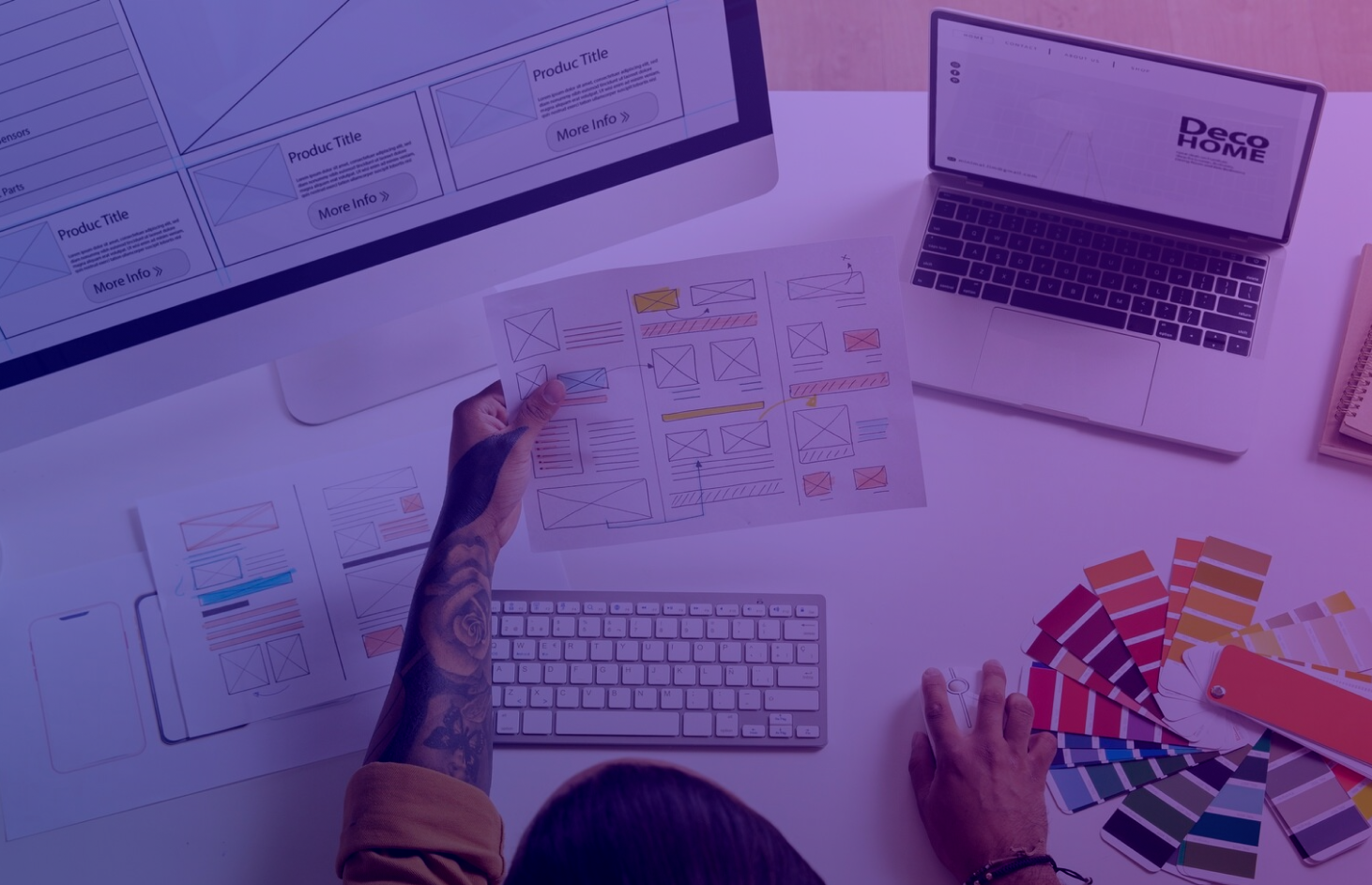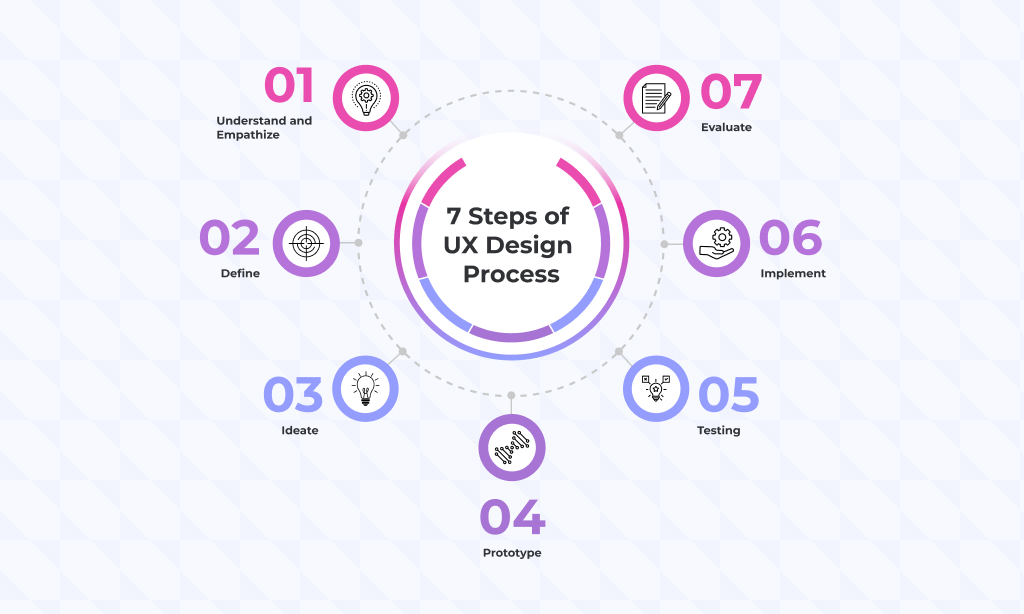Design Thinking: 7 Steps of UX Design Process
February 13, 2024

The path of innovation and creativity is an iterative process where there is a need for continuous refinement and idea improvement. It is necessary to adapt design thinking for problem-solving and innovation. , Even though there is a constant evolution of user demands along with the expanding competition, it is crucial to stand out from the crowd by appropriately brainstorming ideas. It will eventually aid you in adapting to the forthcoming trends, customer needs, and feedback to foster the environment with immense creativity.
So, Design thinking is said to be a human-centric approach that transforms the way products or services are developed and conceived.
If you are also eager to know more about design thinning, then you are at the right place. The blog will give you valuable insights into design thinking and 7 steps of UX design processes.
Why Design Thinking is Crucial?
Being a user-specific approach, design thinking is a process of finding the right target audience for the products and how they will be used. Along with building empathy from the audience, design thinking will aid you in understanding and addressing the user’s concerns.
Considering the user perspectives, design thinking assures the solutions we provide are aligned with real-time problems and user experiences. While focusing and putting efforts into solving the issues and challenges faced by the target audiences, design thinking helps reduce the risk of misalignment between user needs and solutions.
With a holistic approach to understanding the problems, UX design process encourages cross-functional collaboration with diverse skills and perspectives that would help in the creative processes. Prioritizing the user experiences, this process focuses on the usability and accessibility of the products.
What are the 7 steps of the UX Design Process?

Understand and Empathize
It is significant to understand and have proper knowledge about the company and the business goals before starting the project. It is necessary to study well about the industry in case your product or company is new to the market.
With appropriate research, you should be able to answer the questions mentioned here.
- What are the challenges and issues faced by the audiences?
- Who are your target audiences?
Empathizing is all about conducting proper research with a deep understanding of the user behavior, needs, expectations, and demands. It can be done through interviews, card sorting, questionnaires, surveys, and competitor analysis.
Define
In this stage, you will utilize all the information you have gathered in various ways. Synthesizing the information collected, it is necessary to search for the core issues of the target audiences that need to be addressed. It also helps in finding valuable insights and the right pattern of user behavior.
Thinking beyond boundaries from different perspectives and giving ears to the users, you can satisfy them by creating the best product or delivering efficient services. With a well-defined problem, designers can easily succeed in solving user challenges and developing the right product for them.
Ideate
Brainstorming the potential possibilities and ideas in creating a product and how it will satisfy the users is called Ideation. In addition to gathering new ideas, it includes generating new user flows with sitemaps for the products. Without judgments, the researchers and designers have to brainstorm and conduct mind mapping along with collaborative workshops to come up with a wide range of new concepts that would boost innovation and creativity.
Prototype
The process of transforming ideas into a tangible design and examples is called prototyping. It has been conducted when you fix and identify your ideas and user flows for the creation process. Prototyping is the process of sketching your wireframes, including high-fidelity prototypes and low-fidelity prototypes. Being a simplified version of your product will help the designers to analyze and test whether it works properly and fulfills the audience.
Through this testing, the designers will get valuable feedback that will help you rebuild the concepts and make result-oriented decisions for the plans.
Testing
Testing is a process where the designers test the prototypes with real-time users. User testing will help the designers understand how well the products satisfy the products meet the user needs. It can be conducted through observations, surveys, and user testing sessions. The testing enables the continuous refinement and improvement of the final product, satisfying the user’s expectations.
Implement
After appropriate testing and evaluation, it’s time to implement the solution and launch the product. With an effective collaboration with the developers, the implementing phase brings life to the designs with a smooth transition of concepts and ideas into reality and results.
Evaluate
The design process doesn’t end here. Ongoing evaluation is a crucial factor that plays a key role in future strategies. After the product launch, it is necessary to have proper communication with the design and development team, collect user feedback, monitor the performance metrics, and understand the changing user needs.
Wrapping Up
Design thinking is a dynamic approach and a creative user-centric journey. Considering the seven steps of design thinking from empathizing to evaluation, the designers can address the user concerns by creating the products and services that align with the user’s expectations. Fostering innovation, and design thinking will help satisfy the users and embrace their connection with products.
What’s your thought on design thinking? It’s time to walk beyond the user’s expectations and make them happy through various possibilities.
Keep reading about
LEAVE A COMMENT
We really appreciate your interest in our ideas. Feel free to share anything that comes to your mind.
Our 16 years of achievements includes:
-
10M+
lines of codes
-
2400+
projects completed
-
900+
satisfied clients
-
16+
countries served




